Family : Nymphalidae

Texte © Dr Didier Drugmand
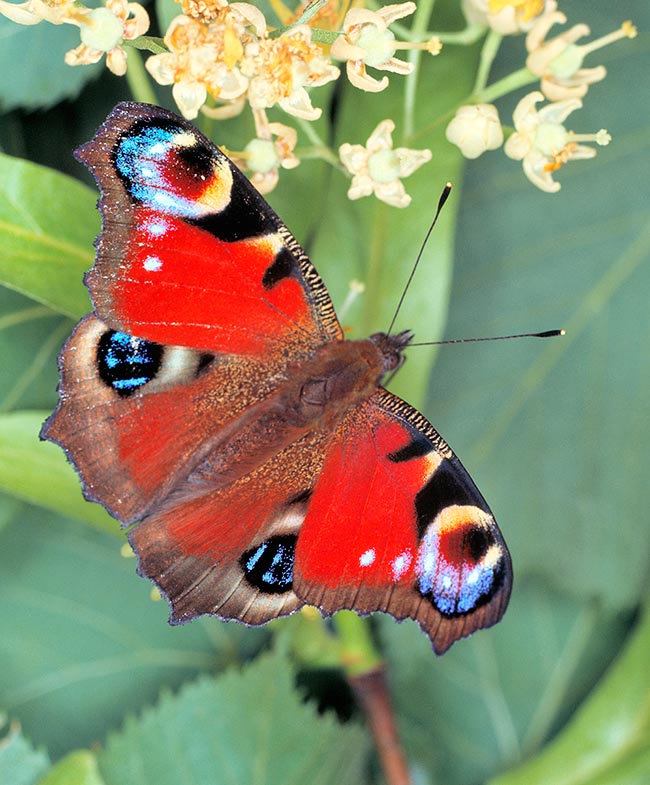
Easy to recognize, Aglais io is one of the most frequent butterflies in Europe © Giuseppe Mazza
Aglais io or “European Peacock” is one of the most common butterflies in Europe, and also the most easily identifiable by everyone because of the 4 eyespots on its reddish wings. Its beauty had been emphasized; as early as 1634, when Théodore Turquet de Mayerne, the Geneva physician to many kings, noted that: ”the ‘eyes’ on the wings of the Peacock butterfly shine curiously like stars, and do cast about them sparks of the colours of the Rainbow”.
This Rhopalocera (butterfly) belongs to the vast Nymphalidae family, with more than 6125 species distributed throughout the world. Several of its species are very common in Western and Southern Europe. The general public often comes across them in their immediate environment, such as gardens or parks. Let’s mention three of them: the Small Tortoiseshell. (Aglais urticae), the Red Admiral (Vanessa atalanta) and the Comma (Polygonia c-album).
Aglais is a genus created in 1816 by the Swedish naturalist Johan Wilhelm Dalman. Today it includes three species distributed in Europe. In addition to the type species Aglais urticae (Linnaeus, 1758), let us quote Aglais ichnusa (Hübner, 1824), the Sardinian Small Tortoiseshell (whose status is still discussed).
The European Peacock was first described by Linnaeus in 1758 and, as usual, about ten Latin words were enough to characterize the species. He classified it in his genus Papilio within the group of “Nymphales gemmati“, or “ocellated nymphs”. Let us note that he had already quoted this species in his work of 1748 (only the 1758 version is recognized by the International Code of Zoological Nomenclature), naming it then: “oculus pavonis” or peacock’s eye! Finally, the first description and figuration of this species (without naming it) comes from a book by Thomas Moffet, published after his death in 1634: “Insectorum sive Minimorum Animalium Theatrum“.
Let us continue with a few words on the etymology of the binomial Aglais io. The name of the genus Aglais comes from the Latin “Aglaia”, itself coming from the ancient Greek Ἀγλαΐα (splendid, shining), derived from ἀγλαός (splendid, brilliant). Aglaia was, in the mythology, the youngest of the three Charities (Graces), the one who personifies the dazzling beauty, the splendor. As for the name of the species io (Ἰώ in ancient Greek), it corresponds, in mythological Greece, to the name of the daughter of the river god Inachos, the first mythological king of Argos.
Until 2003, the species was classified in the genus Inachis and is still found under Inachis io (Linnaeus, 1758) in many books and websites.
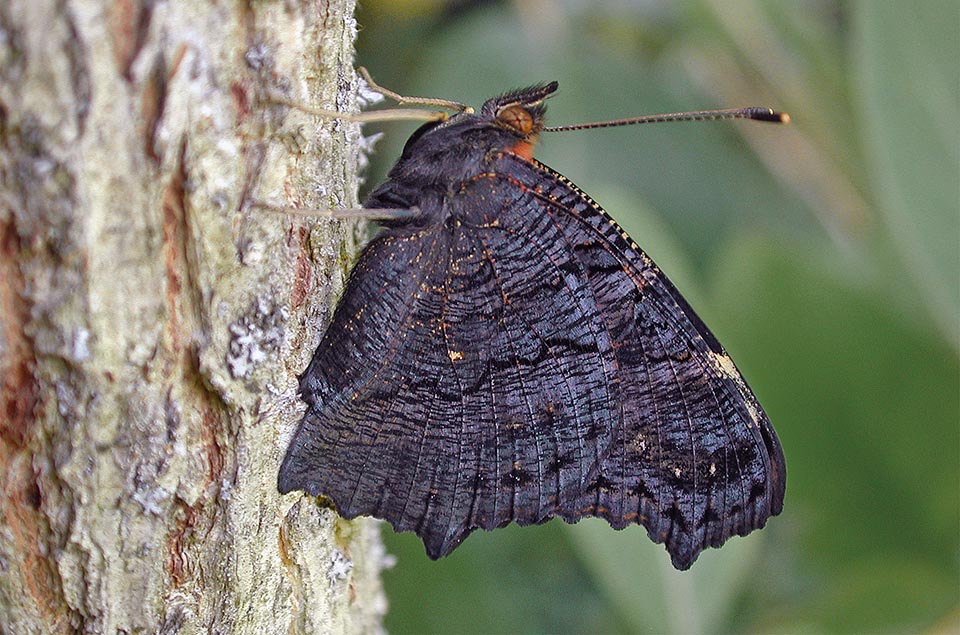
Very mimetic, the underside of the wings, brown-black, is marbled with wavy brownish and yellowish lines more or less clear © Nammour Ezzat
In French, Aglais io is known under the vernacular name of “Paon-du-jour”, “oeil de paon”, or more rarely “cocarde”; in English: “European peacock” or “Peacock (Butterfly)”, in Italian: “la Vanessa io” or “Occhio di pavone”, and in Spanish: “la Mariposa pavo real”.
Some studies recognize the existence of two subspecies: Aglais io caucasica (Jachontov, 1912) in Azerbaijan and Aglais io geisha (Stichel, 1908) in Japan. We will not discuss these two non-European taxa in this record.
Zoogeography
This Eurasian species is widespread, particularly throughout western and southern Europe. It is, however, lacking in the south half of the Iberian Peninsula. Aglais io was introduced into North America towards the end of the 20th century.
It should be noted that in Scandinavia, as a result of global warming, the populations of the European Peacock and the Small Tortoiseshell (Aglais urticae) are declining, due to strong competition with the Map (Araschnia levana).
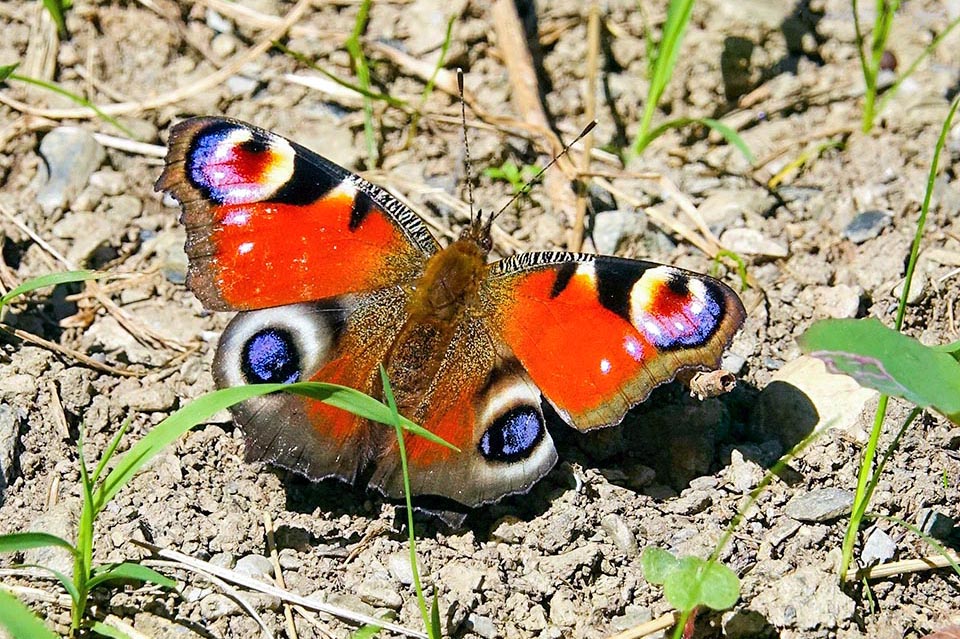
Aglais io warming himself in the sun. To ensure that its wing muscles work optimally, it needs a thoracic temperature approaching 30°C © Nammour Ezzat
Habitat and Ecology
The European Peacock, a powerful flying butterfly, has no specific biotope. Mesophile, it can be observed in biotopes rich in nectariferous plants on the plains up to 2500 m altitude. Avoiding environments that are too dry (except at the beginning of the season), it frequents uncultivated land, pastures and hay meadows, forest edges and paths, wastelands, urban parks and gardens.
The caterpillars live in communities on stinging nettle (Urtica dioica) in a web of loose silk (see below). When they reach the last instar, they disperse and move to pupate on the host plant, but also nearby, on various shrubs and even under other mineral substrates.
In autumn, the imagos seek out tree cavities, wood piles… and, in the vicinity of man, cellars, barns and attics that will serve as their winter retreat. Favorable sites can accommodate several dozen individuals. The overwintering butterflies can withstand temperatures as low as -20 °C.
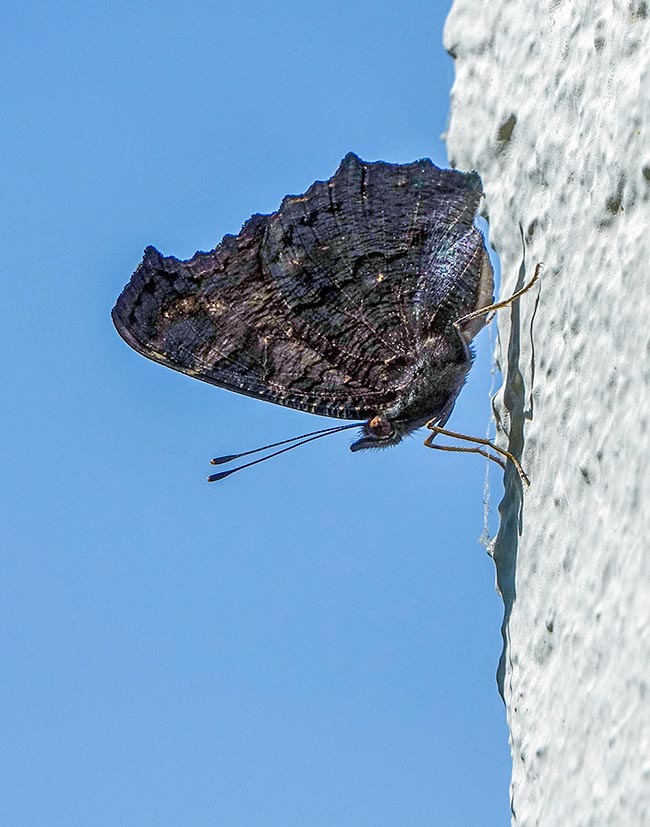
Male watching its territory. It is waiting for the passage of a female and attacks the rivals © Nammour Ezzat
Aglais io is the only butterfly considered as regularly trogloxene, during the winter and sometimes during the summer resting period: it is not rare to meet it in natural or artificial underground cavities (caves and caverns, old mines, pipes, rabbit holes and various tunnels.
Aglais io locates food plants based on their visual appearance, their odours, but also their sugar content (with a preference for flowers with a higher proportion of sucrose than fructose, then glucose). This choice is not innate for the butterfly, but is based on learning, which gradually enables it to select the flowers that are most interesting for it.
At the time of mating, the differences between the sexes in their search for food are more pronounced, because males and females differ in their main activities, their physiology and the management of their energy care. For example, males are more active in their search for mates than females, while females are more active in their search for the ideal nettle for egg-laying. In addition, their eggs must mature at the time of mating. On the other hand, males and females make the same choice of flowers at the end of the season, as both need the same nutritional and energy intake for their winter diapause.
In order to accumulate essential fats during the winter, adults feed on nectar from a variety of wild or ornamental flowers belonging to very diverse families. These include, but are not limited to: blackthorn (Prunus spinosa), hyacinths (Hyacinthoides non-scripta), brambles (Rubus spp.), butterfly-bush (Buddleja davidii), many Asteraceae such as common fleabane (Pulicaria dysenterica) and dandelions (Taraxacum spp.), mayflower (Cardamine pratensis), hawkweeds (Hieracium spp.), hemp-agrimony (Eupatorium cannabinum), ragwort (Jacobaea spp.), thistles (Carduus spp. and Cirsium spp.), water mint (Mentha aquatica), wild marjoram (Origanum vulgare), wild privet (Ligustrum vulgare), and yarrow (Achillea millefolium). The main food plant of the caterpillars is stinging nettle (Urtica dioica). More rarely, in Great Britain, Switzerland and Northern Italy, naturalists have also observed them on hops (Humulus lupulus) and annual nettle (Urtica urens).
Morphology
Egg
Ovoid, pale green to yellowish green in colour. Their external envelope is crossed by thin, more or less parallel, whitish ridges meeting at the two poles.
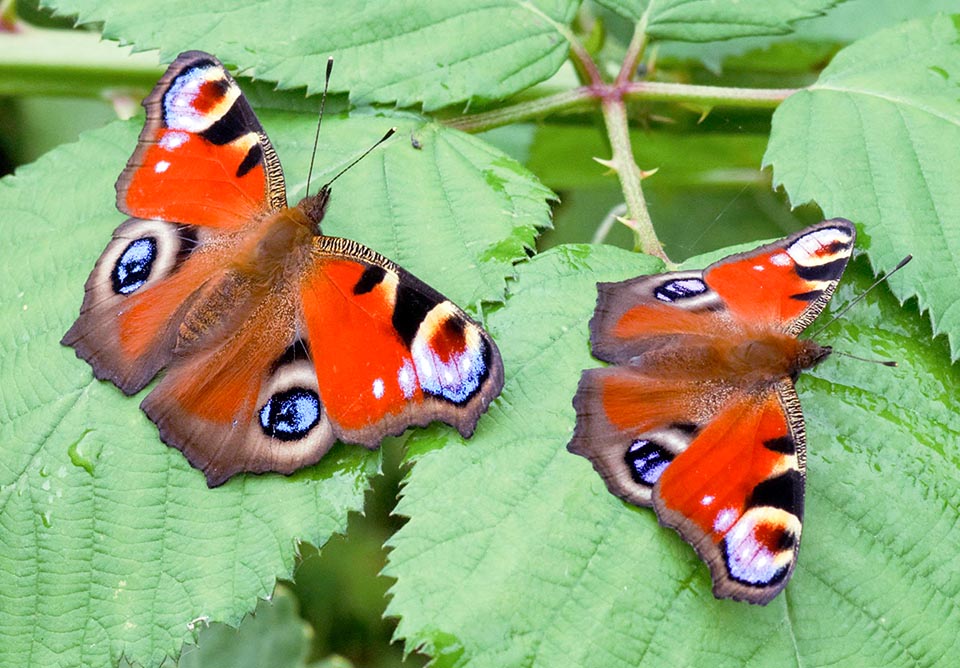
If the female accepts the male’s company, mating usually takes place in the late afternoon. It would last most of the night © Rog Gray
Caterpillar
Immediately after leaving the egg, the caterpillar is 1.5 mm long. Its body is cylindrical with a shiny black head, sprinkled with fine black hairs. On the body, there are four longitudinal rows of long, fine, black and simple hairs with bulbous bases. The colour is a very light ochre green, almost white green. Before the second moult, about nine days after the egg-laying, the caterpillar measures, on average, 8 mm. It is very similar to the previous instar.
The third moult begins more or less two weeks after hatching, and the length of the caterpillar ranges from 12.5 mm to 15 mm. It is particularly voracious during this instar. Before the fourth moult, at 18 to 20 days of age, the caterpillar is about 25 mm long. Its size will quickly reach 40 mm and sometimes even 50 mm.
Older caterpillars are generally black in colour with white specks. The black of the legs contrasts with the orange of the false legs. Each segment has a crown of long, stiff spines with fine short hairs in the middle. Hair and spines are not stinging.
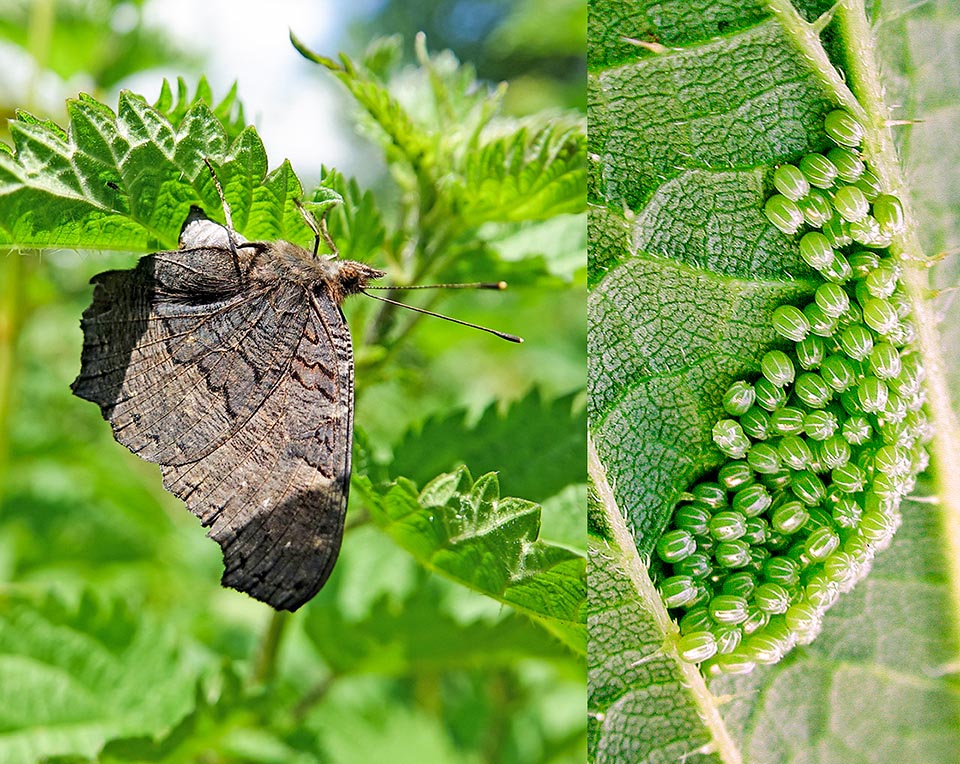
Females lay 30-80 eggs, rarely as many as 500, on the underside of a nettle leaf. Eggs hatch in 1-3 weeks © Nammur Ezzat (left) © Jochen Behrmann (right)
Chrysalis
The chrysalis measures on average 25 mm long for the male and 29 to 30 mm long for the female. It is attached upside down to a stem or a leaf by the cremaster. It is known in two chromatic forms: one generally yellow brown and the other dark grey; the colour depends on the site of metamorphosis. This instar lasts between 2 and 4 weeks, depending on the temperature.
Adult
The adult butterfly is easily identified by its general coloration. Its wingspan ranges, depending on the region, between 50 and 60 mm and the length of its body between 18 and 25 mm.
The dorsal surface of its four wings is wine-red with a sooty brown border and four eyespots. The forewing eyespots are tinged with blue, purple, black, and yellow, while the hindwing eyespots are bicoloured, blue, and black. They resemble the “eyes” on the tail of the Peacock (e.g. Pavo cristatus). Note that rare forms, called “achromatic”, do not have eyespots.
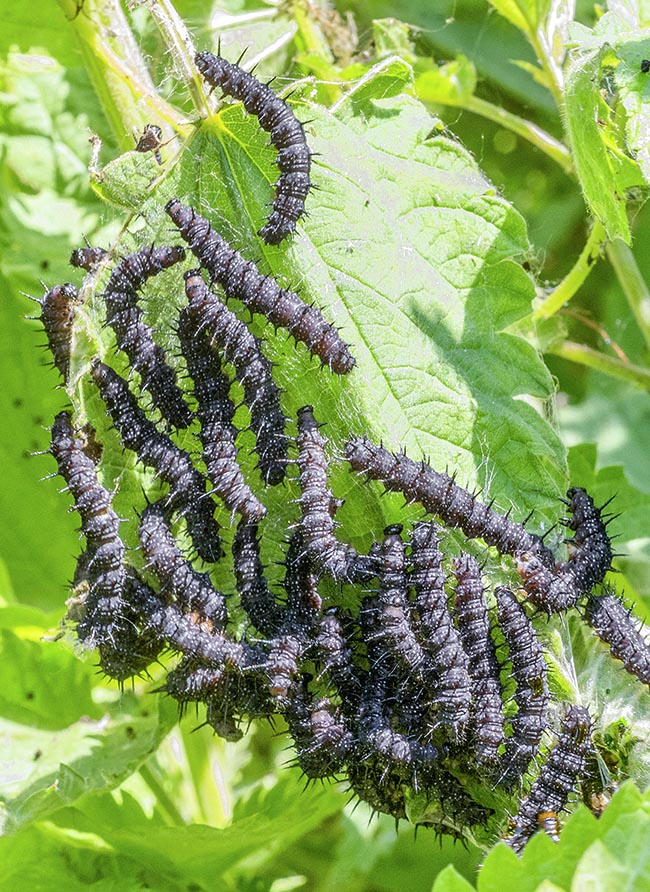
The caterpillars live in communities on stinging nettle in a web of loose silk. They have 5 larval instars. Worried by a predator, they shake in cadence to try to scare it off. If necessary, they curl up into a ball, then drop to the ground © Gianfranco Colombo
The underside of the wings is black brown, marbled with wavy brownish and yellowish lines that are more or less distinct. With closed wings, the Peacock vaguely resembles the large tortoiseshell (Nymphalis polychloros), although the underside of the latter species is much darker. The body is dark with a thorax covered with reddish hair and a brown abdomen stained with yellow. The antennae are black brown with the last article yellow. The legs are light brown.
Ethology-Reproductive Biology
Cycle
Most often bivoltine species in Western and Southern Europe. Most European Peacocks fly from late April to mid-July and then from mid-August to late October. But a few individuals, on mild and sunny days, already leave their wintering sites in February, sometimes even in January. In northern Europe, especially in Great Britain and Germany, Aglais io is rather univoltin, often flying from March to October. Note that in south-western Europe, in warm years, there is a partial third generation in autumn, when the butterflies born in summer have already reached their winter habitats.
Females lay 30-80 (rarely up to 500) eggs on the underside of a nettle leaf. They are laid in disorderly heaps at a height of between 5 cm and 1 m. Disturbed by a predator, the female will fly away, then return shortly after completing the laying of its eggs on the same leaf. The nettles chosen are generally those not colonized by the Small Tortoiseshell (Aglais urticae). The eggs hatch in 1 to 3 weeks.
When the eggs hatch, the caterpillars build a common web near the top of the plant, from which they emerge to warm themselves in the sun and feed. They are usually highly visible. As they grow, they move to other plants, building new webs. These webs are strewn with debris of their cuticle and droppings, so they are easy to find within the nettles. They live there until their third instar.
At the end of the 5 larval instars, they leave the nettle and hang upside down from a low plant or other support to pupate.
The adult will emerge after 10 to 28 days. It will live from a few months to a year (for those that overwinter); males live shorter than females.
Warm-up
In windy or cool weather, the butterfly walks to a sheltered spot and places its wings on the ground to optimize the reception of solar energy. It needs a thoracic temperature of around 30° C for its wing muscles to function optimally and allow it to fly efficiently.
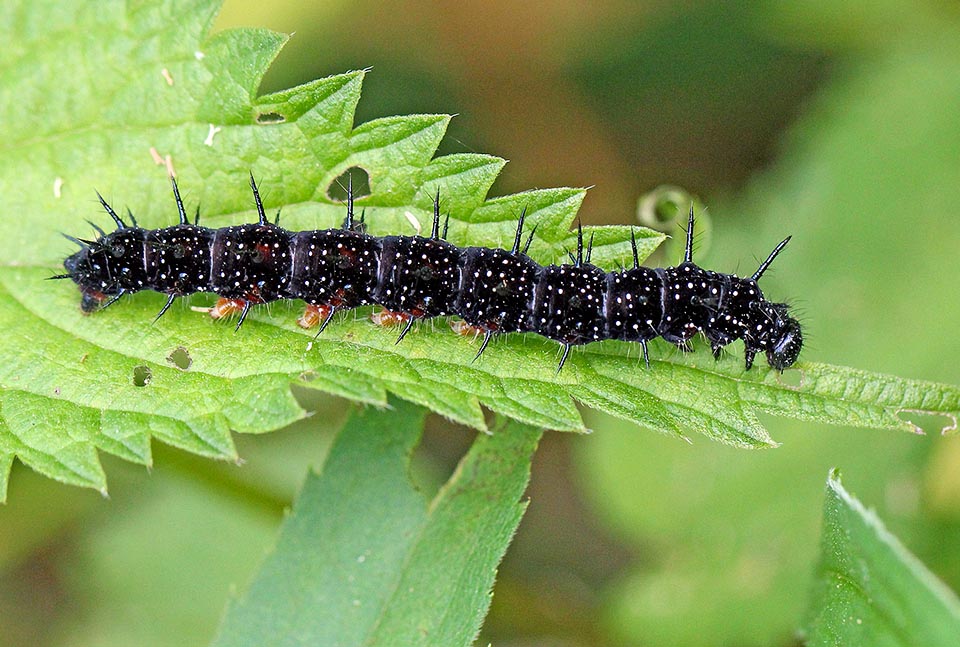
Older caterpillars have a general black coloration with white specks. The black of the legs contrasts with the orange of the false legs. Each segment has a ring of long, stiff spines with fine short hairs in the middle. Despite their worrying appearance, the hairs and spines of the European Peacock are not urticating © Michel and Paule Ehrhardt
If the sun runs out or if the European Peacock is in the shade, it will not be able to take off quickly due to lack of energy. The wings start to shiver, and the internal temperature of the thorax rises rapidly, allowing the butterfly to fly quickly. This behaviour is frequently observed in males that are on the ground watching their territory.
Migration and dispersion
Aglais io has a nomadic instinct and rarely stays in one place. It has a habitual dispersal tendency within its range. It becomes a migrant butterfly in some very hot years. Some researchers have reported such migrations, especially at night in Great Britain and the Maghreb.
In spring, it will travel less distance daily than in autumn, limiting its movements to its own territory. In autumn, when it must feed more abundantly, it will travel greater distances. The distance it travels will depend mainly on the distance and abundance of flowering sites where it will feed. These distances vary between 1 and 5 km per day.
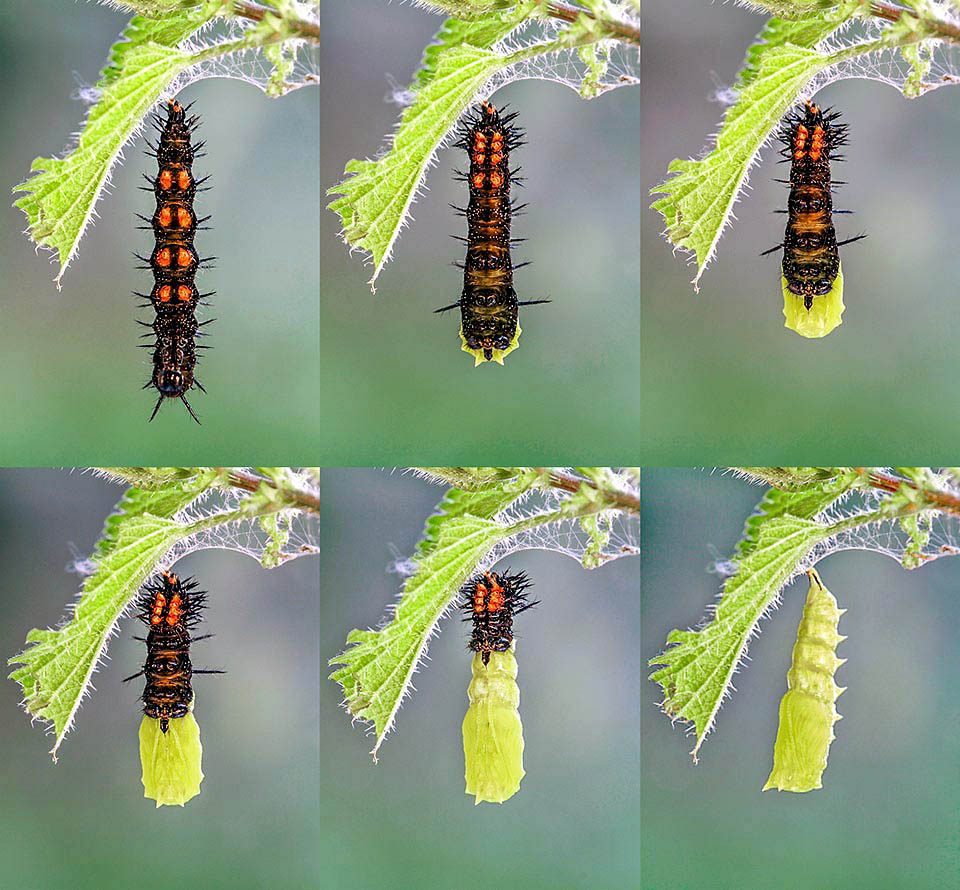
With its head downwards, the last instar caterpillar fixes itself by the tip of its abdomen to a support: a leaf, like this nettle, or a stem. The very strong attachment area is called the cremaster. Gradually, starting from the head, it transforms into a yellow-brown or dark grey chrysalis depending on the site of metamorphosis © Silvia Reiche
Courtship display and mating
Males, like those of Aglais urticae, are territorial. They spend most of the morning feeding on nectar, then establish territories around noon, often in warm, well-lit sites, at the edge of a wood, a hedge, a sunny slope… They wait there for a female to pass. They are often placed on bare ground or grass; some studies also report them on low branches. Up to a dozen males sometimes set up their territories close to each other. It seems that males change their territories on a daily basis. They quickly fly off to any dark object (leaf or insect) and chase away the intruder. When a female is spotted, the male chases it quickly, sometimes inadvertently violating another male’s territory. A territorial battle ensues, and the female often escapes to other locations. If the female accepts the male’s presence, mating usually takes place in the late afternoon. It would last well into the night. Females mate only once.
Attacks and threats
Some literature associated with the reports of former entomologists indicates that populations of this butterfly were once larger. Nowadays, a declining trend unfortunately seems to be appearing in certain regions of France and Belgium.
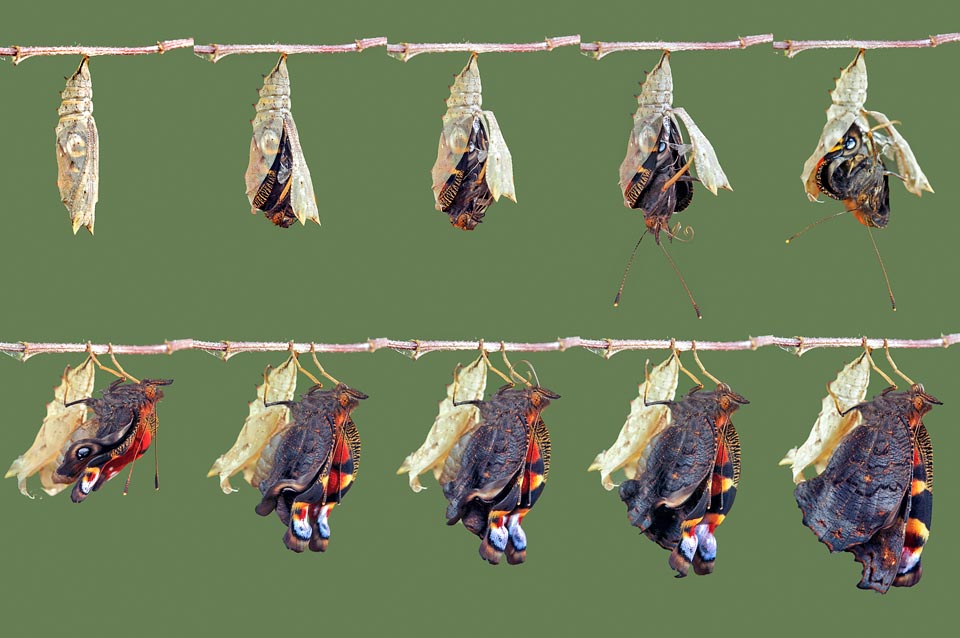
After 2-4 weeks, the adult stage begins to emerge. Chrysalis tears through the ventral side. The butterfly slowly inflates itself with air that penetrates through its stigmata. The body unfolds gradually. The head appears first, then the antennae that point rapidly forward. The butterfly emerges from its chrysalis and turns around © Silvia Reiche
If the destruction of nettles in gardens and around houses can potentially contribute to this decline, the enrichment of certain agricultural fields (with nitrogen amendments) allows a contrario a relative blooming of the nettle and, therefore, of the European Peacock (and the other species related to this plant). Studies have pointed out that, like Aglais urticae, A. io was pre-adapted to higher nitrogen levels in its host plant, stinging nettle (Urtica dioica). Euroepan Peacock and The Small Tortoiseshell living in amended (and therefore higher N-rich) cropping areas showed higher survival rates than in untreated sites, as well as shorter larval periods and heavier nymphs.
Unfortunately, threats to this butterfly also exist. Populations of Aglais io (and probably other species) are impacted by Bt maize, which is increasingly grown in Europe. This GMO maize is genetically modified by adding the gene giving it resistance to the main insect pests. Researchers have discovered that second generation caterpillars of Aglais io feeding on nettles at the edge of Bt maize fields could ingest pollen from neighbouring maize. Abnormal caterpillar mortality was reported in southern and central Europe (but not in northern Europe). Finally, this butterfly is not a species of conservation concern and is not protected in any European country.
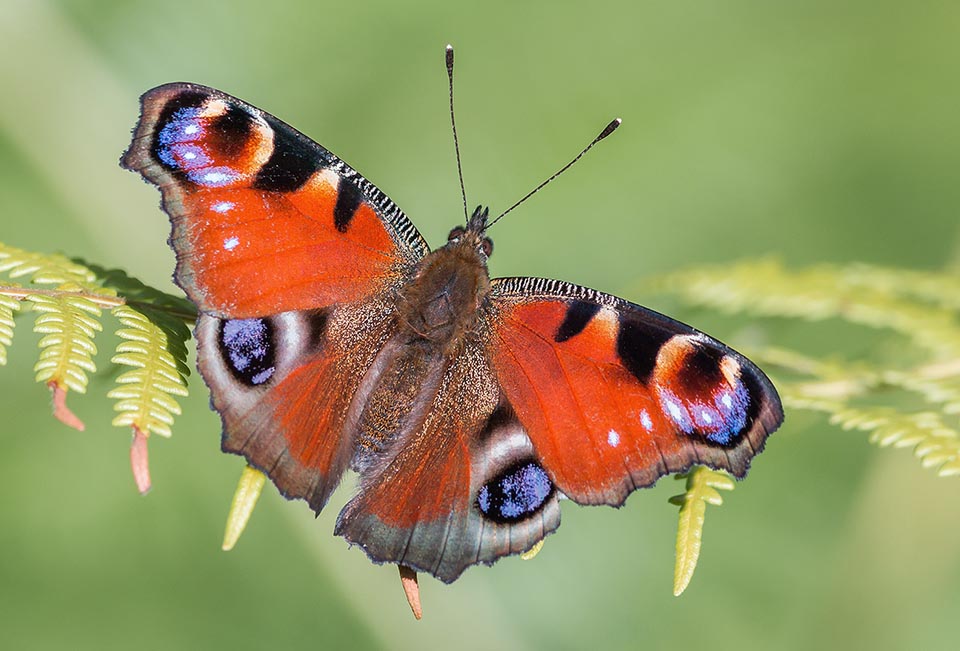
The injection of air and haemolymph finally consolidates the spread wings. Once dry, the butterfly flies away. Here it is now, in all its beauty, ready to conquer the world ©Jose Antonio Diz Orge
Defense against predators
Caterpillars are often victims of passerines that feed their brood, especially the Blackbird (Turdus merula), but also the Robin (Erithacus rubecula), the Great tit (Parus major), the Sparrow (Passer domesticus) … Some species of wasps are also greedy of the early instars of caterpillars.
Worried by a predator, the caterpillars shake in rhythm to try to frighten it off. And, if necessary, they curl up into a ball and drop to the ground. The caterpillars sometimes release a smelly and corrosive green liquid from glands at the back of the head or, according to some authors, through the mouth.
Nevertheless, in some years, at least 90% of caterpillars are attacked by parasitoids, including the fly Zenilla vulgaris (Tachinidae). Other species of this family, including Pelatachina tibialis, Sturmia bella and Phryxe vulgaris, are also known to parasitize Aglais io. These parasitoids cause more or less marked interannual variations in the butterfly’s abundance.
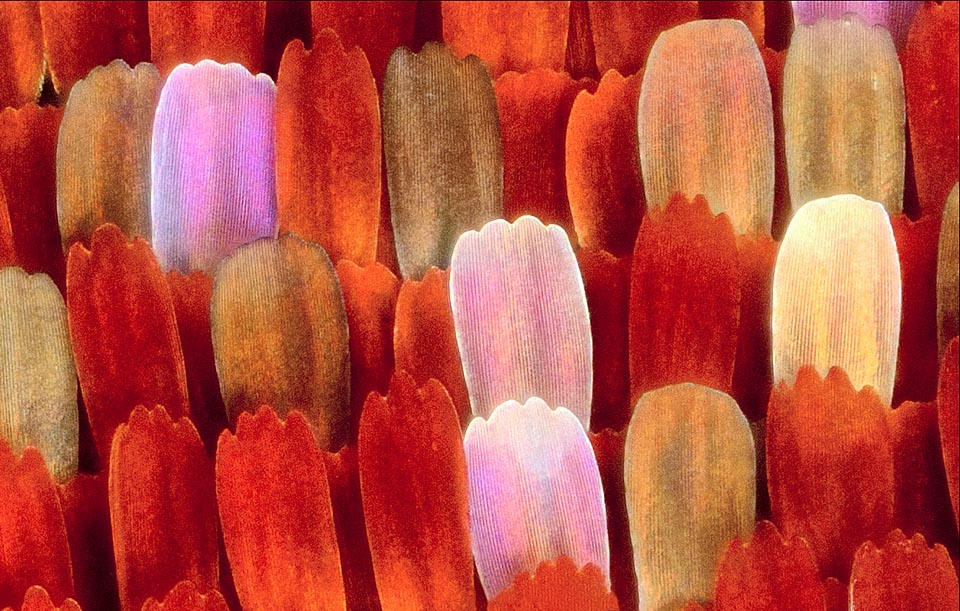
Wing scales are arranged like the tiles on a roof. The final colour can be explained by the succession of facets with shades ranging from purple to red yellow © fotoopa
European Peacocks often close their wings when they are placed on a support, but if they are disturbed, they abruptly reopen them. The sudden appearance of “peacock eyes” probably serves to startle the attacking bird. The stratagem is believed to be effective in over 97% of blue Eurasian blue tit (Cyanistes caeruleus) attacks. But sometimes the fear effect is short-lived and, once its senses are restored, the bird can still attack the butterfly. The “eye-spots” are then used to divert the attack from the butterfly’s vulnerable body and direct it towards the outer part of the wings. It is not uncommon to encounter flying butterflies with one or two triangular incisions corresponding to the beak stroke(s).
With the underside of the wings almost black, the European Peacock at rest blends almost perfectly with the bark of a tree trunk or, in wintering in a dark place, with any support. It then escapes the sight of most winged predators.
During its hibernation in dark areas, the butterfly frequently encounters small mammals, such as several species of shrews, the wood mouse (Apodemus sylvaticus)… Against these predators, the effect of eye-spots is ineffective because of the darkness of the environment. The butterfly then makes a grating or whistling sound that it creates by rubbing the front and rear wing veins against each other. This squeak would frighten off the predator.
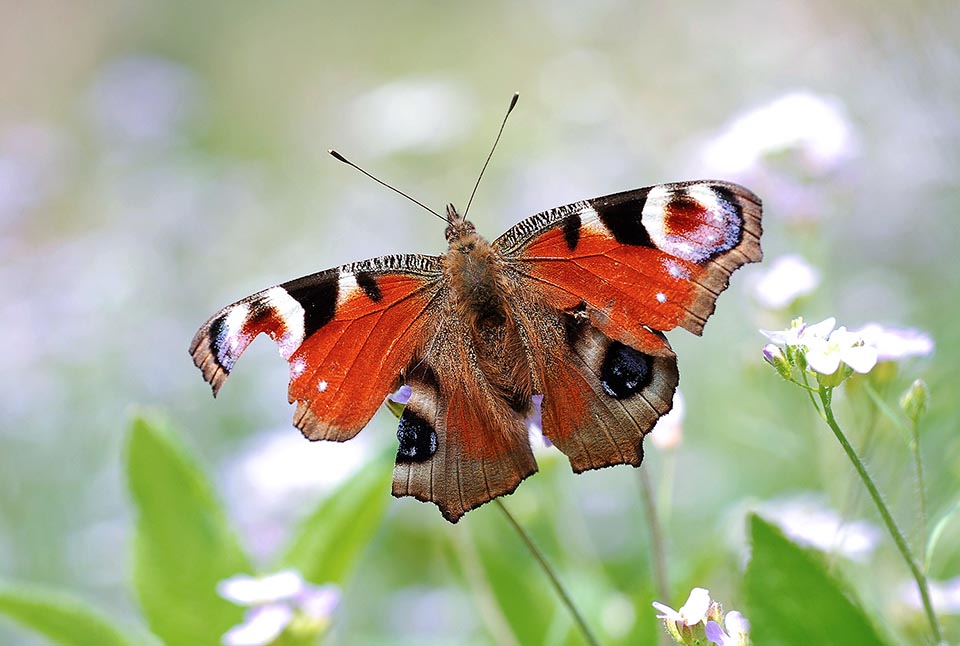
Aglais io with triangular incisions corresponding to the beak strokes of a bird. The “eye-spots” serve to divert the attack from the butterfly’s vulnerable body and direct it towards the outer part of the wings. In spite of predators, parasites and human activities, this beautiful butterfly is not an endangered species today © Gilles San Martin
Some authors believe that European Peacocks also produce ultrasound generated by a rigid portion of the wing membrane near the base of the forewing, between the costal and subcostal veins. These ultrasounds are thought to be a defense against bats such as the brown long-eared bat (Plecotus auritus) and the Common Pipistrelle (Pipistrellus pipistrellus), which are present in caves or even in the trunks of hollow trees in which the butterfly shelters or hibernates. To be validated, these last observations require further research.
Management guidance and conservation measures
We refer the interested reader to those given for Aglais urticae.
Synonyms
Papilio io Linnaeus, 1758; Papilio ioides Ochsenheimer, 1807; Vanessa io (Linnaeus, 1758); Nymphalis io (Linnaeus, 1758); Vanessa io subsp. ioides (Ochsenheimer, 1807); Vanessa jo (Linnaeus, 1758); Inachis io (Linnaeus, 1758); Vanessa io var. sardoa Staudinger, 1871; Vanessa io ab. exoculata Weymer, 1878; Vanessa io f. veronensis Garbini, 1881; Vanessa io ab. belisaria Oberthür, 1889; Vanessa io ab. fischeri Standfuss, 1892; Vanessa io ab. calorefacta Urech, 1897; Vanessa io ab. jokaste Urech, 1897; Vanessa io var. narses Schultz, 1899; Vanessa io ab. pavo Stichel, 1902; Vanessa io ab. cyanosticta Raynor, 1903; Vanessa io var. fulva Oudemans, 1905.
→ For general notions about the Lepidoptera please click here.
→ To appreciate the biodiversity within the BUTTERFLIES please click here.
